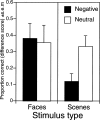Emotional memories are not all created equal: evidence for selective memory enhancement
- PMID: 17101871
- PMCID: PMC1783624
- DOI: 10.1101/lm.388906
Emotional memories are not all created equal: evidence for selective memory enhancement
Abstract
Human brain imaging studies have shown that greater amygdala activation to emotional relative to neutral events leads to enhanced episodic memory. Other studies have shown that fearful faces also elicit greater amygdala activation relative to neutral faces. To the extent that amygdala recruitment is sufficient to enhance recollection, these separate lines of evidence predict that recognition memory should be greater for fearful relative to neutral faces. Experiment 1 demonstrated enhanced memory for emotionally negative relative to neutral scenes; however, fearful faces were not subject to enhanced recognition across a variety of delays (15 min to 2 wk). Experiment 2 demonstrated that enhanced delayed recognition for emotional scenes was associated with increased sympathetic autonomic arousal, indexed by the galvanic skin response, relative to fearful faces. These results suggest that while amygdala activation may be necessary, it alone is insufficient to enhance episodic memory formation. It is proposed that a sufficient level of systemic arousal is required to alter memory consolidation resulting in enhanced recollection of emotional events.
Figures





References
-
- Adolphs R., Tranel D., Damasio H., Damasio A. Impaired recognition of emotion in facial expressions following bilateral damage to the human amygdala. Nature. 1994;372:669–672. - PubMed
-
- Adolphs R., Cahill L., Schul R., Babinsky R. Impaired declarative memory for emotional material following bilateral amygdala damage in humans. Learn. Mem. 1997;4:291–300. - PubMed
-
- Adolphs R., Tranel D., Hamann S., Young A.W., Calder A.J., Phelps E.A., Anderson A., Lee G.P., Damasio A.R. Recognition of facial emotion in nine individuals with bilateral amygdala damage. Neuropsychologia. 1999;37:1111–1117. - PubMed
-
- Adolphs R., Gosselin F., Buchanan T.W., Tranel D., Schyns P., Damasio A.R. A mechanism for impaired fear recognition after amygdala damage. Nature. 2005a;433:68–72. - PubMed
-
- Adolphs R., Tranel D., Buchanan T.W. Amygdala damage impairs emotional memory for gist but not details of complex stimuli. Nat. Neurosci. 2005b;8:512–518. - PubMed
Publication types
MeSH terms
LinkOut - more resources
Full Text Sources
Medical
